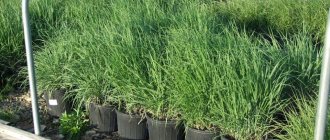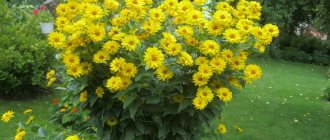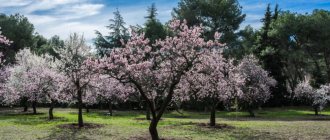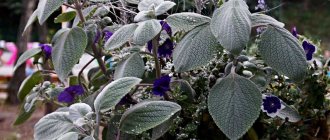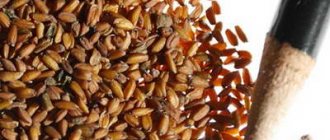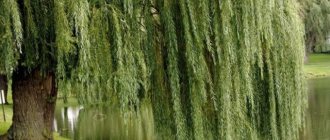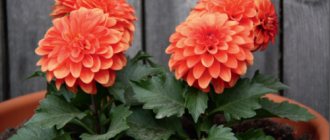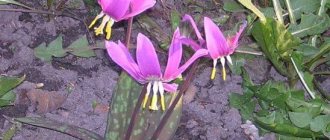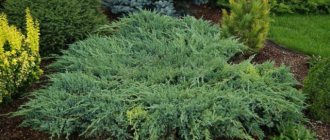Types and varieties
- Chinese . Wisteria reaches up to 20 m in height.
- Japanese (profusely flowering) . The plant grows above 9 m, its flowers have a fragrant aroma.
- Shrub (American) . Wisteria grows very slowly. It reaches a height of 12 m.
- Frost-resistant . The fruits appear in late spring.
- Silky (short-tasted) . A climbing shrub reaches 8 m in height. The length of the inflorescences is up to 21 cm. This wisteria is often used to form dwarf trees (bonsai).
- Short-toothed . The flowers are small, purple, about 1.5-2 cm. The length of the inflorescences is up to 18 cm.
- Fluffy . A relatively small vine, it has thick stems with dense feathery leaves. The flowers are fragrant, purple in color, up to 2.5 cm.
- Beautiful . It is distinguished by small white and purple flowers, grows up to 5 m. This is the most beautiful type of wisteria.
- South . A large tree up to 20 m tall with a very dense crown. Racemes with blue, white, purple flowers reach 15-20 cm.
Chinese wisteria
It has dense large foliage, inflorescences up to 30 cm long. Chinese wisteria blooms almost all summer. It grows in open ground in the south of Russia. The flowers have a pleasant sweetish aroma. During active growth, the vines curl counterclockwise. Popular varieties: Amethyst, Blue Sapphire, Prolific, Texas White and Alba .
Japanese
The abundantly flowering wisteria (floribunda) is one of the most common types of vines. Its height is 8-10 m. The plant is distinguished by a large number of violet-blue inflorescences. Leaves are up to 40 cm long. Japanese wisteria blooms from mid-May to the second half of June. Varieties: Shiro Noda, Issai, Violacea Plena, Multijuga, Lawrence, Texas Purple.
American (shrub) wisteria
Grows up to 8 m in height. The plant’s homeland is North America; in Russia it is found in Chisinau and Crimea. Wisteria grows green mass very quickly. Its leaves are small, but the inflorescences with blue-purple and blue buds reach 30 cm in length. The plant tolerates frosts well down to 20 °C. It begins to bloom in June and ends in August. Varieties: Longwood Purple, Amethyst Falls, Nivea .
Wisteria macrostachia (winter-hardy)
Easily tolerates temperatures down to -40 °C. The height of wisteria reaches 6-7 m. Its flowers are large, lavender-blue in color with a light sweet aroma. This species requires virtually no pruning. In case of severe freezing, the vine is restored due to dormant buds and a powerful root system. Famous varieties are Blue Moon, Clara Mac, Aunt Dee.
Silky
A variety of Japanese wisteria, but its foliage is covered with fluffy hairs. Suitable for the southern regions of Russia. The height of the vine reaches 12 m. The flowers of silky wisteria are small, with a sweetish aroma, collected in inflorescences no more than 15 cm long. It reaches its maximum height 1-1.5 years after planting. Popular varieties: Alba Plena, Shiro Kapitan, Murasaki Kapitan.
Wisteria propagation
The liana is propagated by layering in spring and summer, and by cuttings and seeds only in spring.
Experienced specialists in nurseries grow the plant by grafting.
Wisteria from seeds
Planting material is sown in greenhouses at the end of November or early December, or sown directly into open ground in early spring, in March.
The soil mixture for crops is made up of 4 parts of leaf soil and 1 part of turf soil and sand.
The seeds are laid out on the surface of the substrate, sprinkled with sand, watered, covered with film or glass and placed in a completely dark place with a constant temperature of 20-25 degrees Celsius.
The first shoots hatch after 20-30 days.
After one or a week and a half, the containers with the crops are placed in a lighted place, but at first they are shaded from the sun's rays.
When 2 true leaves are formed, the seedlings dive together with a lump of earth into the beds for growing.
They are securely covered for the winter and transplanted to a permanent place no earlier than next spring, or even after another season.
Wisteria grown from seeds does not bloom soon; the longest time during which you will have to wait for spectacular flowering is about 15 years, so it is advisable to purchase wisteria seedlings that are grown by vegetative methods.
Wisteria cuttings
Fragments of annual pagons 15-20 cm long remaining after early spring pruning will be suitable for cuttings.
For rooting, prepare a substrate consisting of 3 parts of turf soil and 1 part each of sand, humus and peat soil.
Leaves are removed from the bottom of the cutting and 2-3 are left at the top.
The lowest node from the removed leaves should be at a height of 8-12 mm from the cut made at an angle of 45 degrees.
Make a hole 5 cm deep in the soil mixture and place the cutting there, compacting the earth around it.
Cover it on top with a plastic bag, a cut plastic bottle or glass jar and place it in a bright place.
Regularly ensure that the soil mixture does not dry out.
Root formation occurs within 4-8 weeks. Lianas grown by cuttings can delight with beautiful fragrant inflorescences already 4-5 years after planting.
Reproduction of wisteria by layering
As a layering in the spring, a strong one-year-old shoot is selected and a small oblique cut is made in the middle of its length.
Place a pot under this place with fertile clay-turf soil, secure the shoot in it with a wire clamp and sprinkle it with soil. The top of the pagon is lifted up and tied to the support.
They are regularly moistened throughout the summer, and in the last days of August, a seedling with a fairly well-formed root system is cut off from the mother vine and planted in a permanent place of growth.
It also blooms much earlier than wisteria grown from seeds.
Conditions for growing wisteria in open ground
Wisteria is sensitive to air pollution, so it can only be grown in areas with favorable ecology. Over time, the plant develops a tree-like trunk and shoots that need very strong support.
Landing location
It is better to place wisteria on the open sunny side of the site, protected from northern winds. It needs to be trimmed regularly, so the area should be easily accessible. Since wisteria can destroy even centuries-old oak trees, experienced gardeners recommend growing it away from fruit and ornamental trees.
Herbaceous plants will be good neighbors for vines. Garden hibiscus, daylilies, purslanes and large-flowered platycodons get along well next to wisteria. It can be surrounded by daffodils, tulips, imperial hazel grouse or hyacinths. Sometimes roses are planted next to wisteria, but then the bushes will require additional care.
The soil
Planting and caring for wisteria includes careful soil preparation. Loose, fertile soil suits it well. In calcareous and damp soil, the plant develops chlorosis. To prepare the soil for wisteria, mix sand, humus and clay-turf soil in a ratio of 1:1:3. The liana needs to be watered regularly, but excess moisture will destroy it, so make sure there is drainage in the soil. During the budding stage, feed the wisteria with liquid fertilizer once a week.
Let me introduce
Wisteria is a plant that looks like a huge decorative vine that belongs to the legume family. It is mostly tree-like and deciduous, but sometimes there are semi-deciduous specimens that become lignified at the base. The plant received its name in honor of the American professor of anatomy Caspar Wistar and translated from Greek means “sweet”. The plant is grown all over the world for decorative purposes. But the main distribution area is East Asia and North America, mainly in subtropical zones. Also found in the forests of China, Kuban, Crimea, and the North Caucasus. In general, there are 9-10 varieties, but only two are grown in the garden - lush and Chinese.
This is a fast-growing perennial (trees live for 150 years), growing in height up to 18 m. The branches are represented by climbing vines. They are naked (sometimes there are specimens with pubescence) and drooping. The size of the plant is impressive - the girth of the vine can reach 0.4 m. The shoots of wisteria are thin, green, and the bark is gray.
The foliage of Wisteria is imparipinnate, colored in a dark or light green shade, arranged alternately and consists of 7-13 fragments, each of which has an oblong-ovate or narrow elliptical shape. In general, the leaf length reaches 30 cm.
Wisteria blooms twice a year. The first time is in March-May, the second time is in the middle or end of summer. Some species may have different bud opening times. Externally, the flower is a drooping cluster consisting of many densely planted buds. On average, the length of a bunch is 10-80 or 100-120 cm. The flowers bloom from the base to the top of the bunch, emitting a delicate aroma. There is a snow-white corolla and a zygomorphic perianth.
The color of the buds is varied. Mostly pink, white, various shades of purple and lilac.
At the end of flowering, fruits are formed - pods 15 cm in size, containing flat-round seeds, colored brown-black.
When growing and caring for wisteria (photos of the most luxurious specimens are presented), you need to remember that some plants are poisonous, so you should be extremely careful and wash your hands thoroughly after contact.
When and how to plant a plant
Rooted cuttings are placed in the ground at the end of summer. The support for wisteria must be very strong. During growth, a powerful vine destroys everything that interferes with it - pipes, external cladding of the house, weak trees, light roofing. Wisteria will not live on thin trellises for more than 2-3 years; the structures will collapse under the weight of the plant.
Garden arches made of concrete and small gazebos with strong supports are considered ideal for growing wisteria.
Formation of bushes during planting
When small shoots are moved into a site, it is important to give them room to actively grow. The bush is formed in the spring, in the first year after planting. To do this, the strongest shoot is cut off by a third from the top (to a strong bud).
Air temperature and humidity
Wisteria does not tolerate heat or excessive cold. It grows well at +25 °C. In summer, spray the plant regularly to prevent the leaves from drying out. Mature frost-resistant varieties tolerate temperatures down to -30 °C well, even without shelter for the winter.
Liana care
The plant needs to be watered, fed and pruned on time. Do not put too much mineral fertilizer. An excess of potassium will cause abundant foliage growth and a change in color. In winter, young vines are covered to protect them from the cold.
Watering and fertilizing for wisteria
The first year of life the vine grows quickly, so it needs a lot of moisture. Then the frequency of watering is reduced. From late autumn to early spring, the plant does not need moisture, because it begins a rest period. In very hot weather, spray wisteria with water early in the morning.
Organic and inorganic fertilizers are used for feeding. They are added to the soil in March when the first leaves appear.
To stimulate flowering, the plant is fed with potassium mixtures. Iron salts applied under the root system of wisteria will help cope with yellowing of the leaves. The plant is well suited to fertilizing fruit trees. There is also a special fertilizer for wisteria.
Organic fertilizers:
- wood ash;
- eggshell;
- manure;
- chicken droppings.
Trimming scheme
Regularly remove old and dead branches to encourage abundant flowering of wisteria as new shoots grow. The liana is pruned at the end of winter and in mid-summer. Do this for the first 2-3 years to prepare the foundation for permanent stems. Then the plant will form a “skeleton” and to form the crown of the vine you will need to trim off the excess shoots in the summer.
Preparing for winter
For the winter, the shoots must be wrapped from frost. Indoor varieties do well indoors at a temperature of +10°C. When growing and wintering at home, wisteria does not need to be sprayed. If the air in the room is dry due to the heating system, place containers with water near the plants.
Before wintering, young street vines are carefully detached from the support and laid on the ground. Sprinkle the top with soil and then cover it with spruce branches or artificial material for mulching. Adult wisteria will not die in winter. The plant can withstand temperatures down to -25°C.
Wisteria - care and cultivation
To grow wisteria and properly care for it , first of all, you need a lot of sun. The flower should receive at least half of the daylight hours; this is necessary to ensure good flowering. Any climbing plant, including wisteria, needs support so that it can grow. During the warm period, watering is provided without waterlogging the soil. The plant does not like excess moisture, this has a bad effect on its condition. It is best to use light but fertile soil. Once the buds appear, it is recommended to feed the plant with liquid fertilizer weekly.
Growing will not be labor intensive if you follow the rules and conditions. In principle, the soil does not need to be fertile for growth. But by loosening the soil and adding fertile additives as care, we will get proper flowering and beautiful foliage. It is necessary to monitor the degree of soil moisture and provide support. It is better to keep the roots in a shaded place, and the crown in the sun.
Insulation for the winter is carried out according to the same principle as for grapes. In central Russia, some varieties of wisteria can withstand temperatures down to -20 degrees C°, but subject to insulation. The plant does not tolerate more severe frosts.
To obtain beautiful flowering, care is recommended in the form of pruning branches after flowering. Shoots growing from the side are shortened by 2/3 of their length. The second pruning is done at the end of the leaf fall period. You can cut off all the side branches, up to 5 buds remaining for development. Wisteria does not grow very quickly, producing flowers in the fourth year or later. Timely pruning followed by tying it to a support during the entire growing stage, although it does not accelerate the growth of the plant, makes its flowering more luxurious, which requires such care.
How to give wisteria the shape of a standard tree
Without support, the liana will immediately fall to the ground, so the main task of the gardener is to develop the trunk of the plant. This will take at least 4 years. When forming a standard tree, make sure that the wisteria tends upward. While you are creating the framework for the future plant, do not allow it to bloom.
Rules for forming a standard tree:
- Identify the main trunk and eliminate any unwanted shoots.
- Limit sudden growth of the vine by pruning.
- Keep the main trunk growing. Form a crown from the side shoots and maintain with regular pruning.
- As the vine grows, prune the lower branches.
- Make a reliable, collapsible support for the tree. While wisteria is young, the trunk may become deformed. Support will prevent this.
Reproduction methods
Young shoots are obtained in different ways. The liana is propagated by dividing the bush, seeds or cuttings. The most effective methods of propagation are root grafting and rooting of air layering. In other cases, the result is not always predictable.
Dividing the bush
The procedure is carried out in early spring. For division, bushes no older than 5 years are used. Old plants do not tolerate transplantation well, so they may stop flowering. To propagate, the bush is dug up, the roots are cleared of soil, and they are divided into 2-3 parts. Immediately plant the vines in the prepared holes.
Advantages of the method:
- maternal characteristics are completely preserved;
- the young plant blooms profusely after 1.5 years.
Seeds
Planting material is sown in a greenhouse in late November or early December. Seeds can be bought at the store or collected yourself. The advantage of this method is the ability to completely control the growth process of the vine. When propagated by seeds, some seedlings will never bloom.
By cuttings
The procedure is carried out in two ways. In the first, lignified cuttings are used. This method helps to obtain several copies of the plant at once. Cuttings are planted in the fall. Choose branches at least 8 cm long and with 2 developed buds.
The second method is to use root cuttings. In summer or autumn, dig up an adult wisteria, cut off a third of the roots, and add fertile soil. Repeat the manipulation in the spring. Treat young roots with an antifungal agent and plant them in a flowerbed with nutritious soil.
Pros of cuttings:
- many plants take root;
- young vines bloom profusely;
- the characteristics of the species are preserved.
Minuses:
- procedures require accuracy;
- for rooting cuttings you need a nutrient substrate;
- Sometimes plants have to be grown.
Wisteria propagation
The easiest way to propagate wisteria is by dividing the bush. This method is only suitable for young plants, aged from 3 to 5 years. Old bushes are simply dug up on one side and a small part of the plant is separated for replanting.
Plant growers claim that planting wisteria in the spring will be more successful, since over the summer the plant will have time to take root and get stronger.
Gardeners very often propagate wisteria from cuttings. When carrying out this manipulation, they dig up the bush of an adult plant, while cutting off all existing roots by a third.
All large roots are cut off directly at the root collar, after which the wisteria is dug in and new nutrient soil is always added to the hole.
It is necessary to choose only those roots that are no thinner than a pencil and have a length of 10 to 15 centimeters. At the next stage, the selected roots are treated with fungicidal preparations and planted in nutritious loose soil.
During this period, the cuttings need moderate watering. In the fall, they are transplanted to a permanent place or to a greenhouse for growing.
Why doesn't wisteria bloom?
- Creepers are obtained from seeds . With this method of propagation, you can wait up to 20 years for the first flowers to appear.
- Insufficient watering . From July to September, plants need a lot of water. During this period, buds are laid for flowering next year. If wisteria does not receive enough watering, it will not bear fruit abundantly.
- Low temperature . Some plants respond to spring frosts by developing premature buds. This can be avoided by protecting the wisteria from adverse weather.
- Rare pruning . Wisteria needs to be cared for regularly, trimmed twice annually. The time for the first pruning is July or August, the next one is February.
Wisteria description
Wisteria belongs to the Legume family, it is a climbing plant with tree-like shoots that can grow up to twenty meters. If you were to weigh a large specimen during the flowering period, then with foliage and inflorescences at this time the mass of Wisteria could be more than thirty kilograms. The long stems of Wisteria curl around the support in a clockwise direction.
Of course, the plant amazes with its size and power, but the main beauty is still in its inflorescences - long clusters of flowers, which, depending on the type of plant, can have white, purple, yellow, pink or some other color. The flowers themselves are small, no more than 2.5 cm, but the size of the inflorescences can reach 35 cm. All the buds bloom at once, so the inflorescence becomes beautiful, lush, but at the same time quite heavy. Inflorescences are formed in the leaf axils or on the apical shoots of the previous year, so you need to be careful when pruning the plant, otherwise you may deprive yourself of the opportunity to admire the flowering.
Depending on the type of Wisteria, flowering occurs from April to June, but with proper care it can repeat at the end of summer, although it will not be as lush as the first time. The flowers have a subtle pleasant scent.
The foliage of the plant is not as beautiful and decorative as its flowers. The leaves are as long as the inflorescences; the plate is assembled from several fragments of a narrow oval shape.
After the end of flowering, in place of the flower, like all legumes, a pod is formed; in Wisteria it is yellowish-gray in color and is poisonous.
Pests and diseases
The wisteria flower rarely suffers from insects. Clover mites and green aphids are dangerous for the plant. If wisteria becomes chlorotic, it can be quickly cured by spraying the leaves with iron chelate. Occasionally, flowers are affected by bud blast (black hairy mold), then the diseased branches are cut off and burned, and the plant is treated with insecticides against the leafhopper, the carrier of the disease.
Green aphid
The pest is controlled using an insecticide solution. The vines are sprayed once weekly until the parasites are completely eliminated. Infusion of tomato leaves, garlic spray and soapy water effectively control green aphids.
Traditional methods are effective only at the initial stage of the disease. In case of massive damage to the vine, use chemicals.
Signs of the disease:
- white coating on leaves;
- shoots become bent;
- leaves and buds fall off;
- Sticky honeydew appears.
Clover mite
The pest is destroyed using liquid chemicals. Many combination insecticides also help kill aphids. Spray the product early in the morning or late in the evening to prevent the vine from burning in the sun.
Signs of clover mite infestation:
- dark red eggs on leaves;
- change in leaf color to a bronze tint;
- dark strokes and stripes on the processes.
